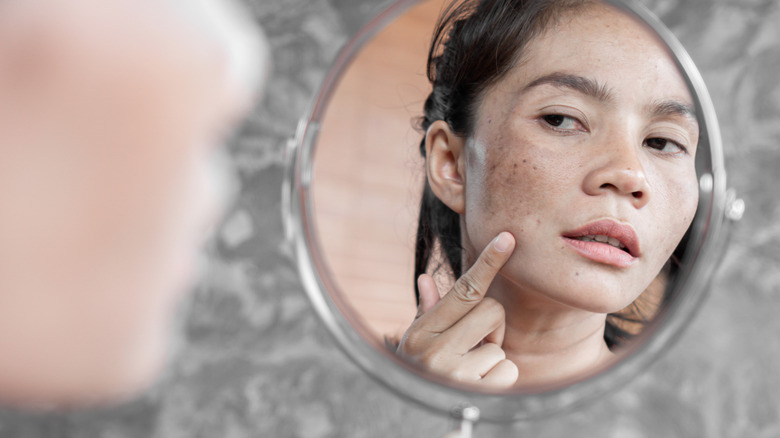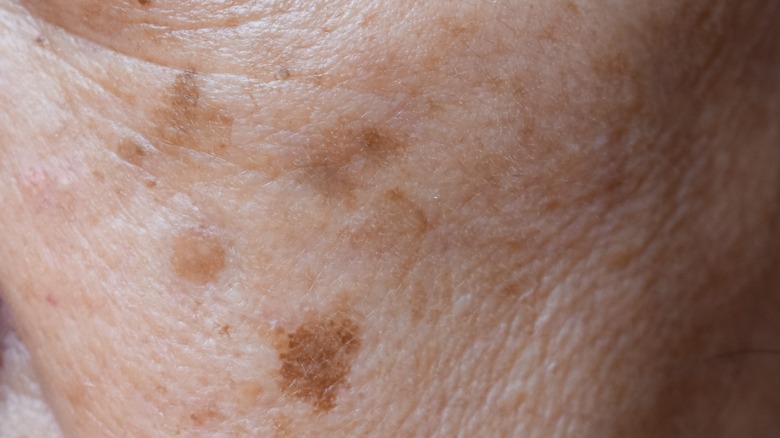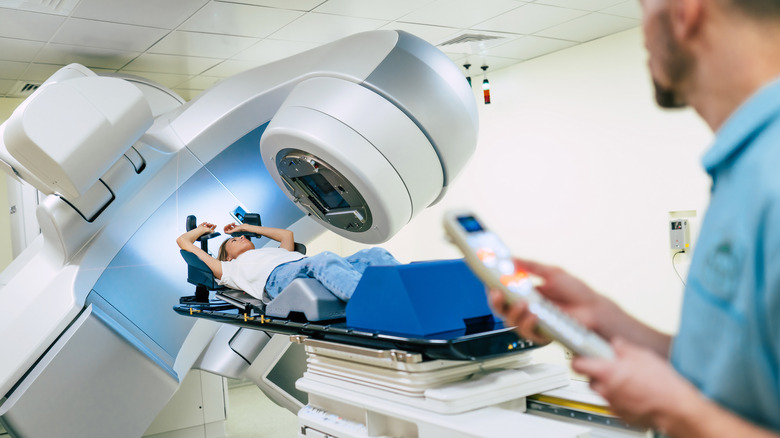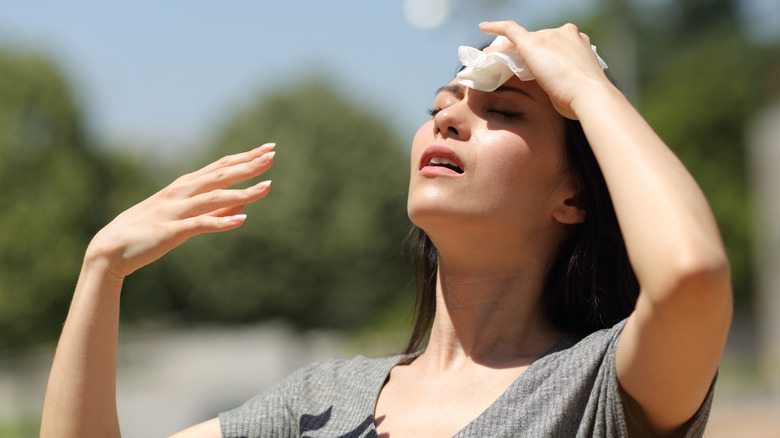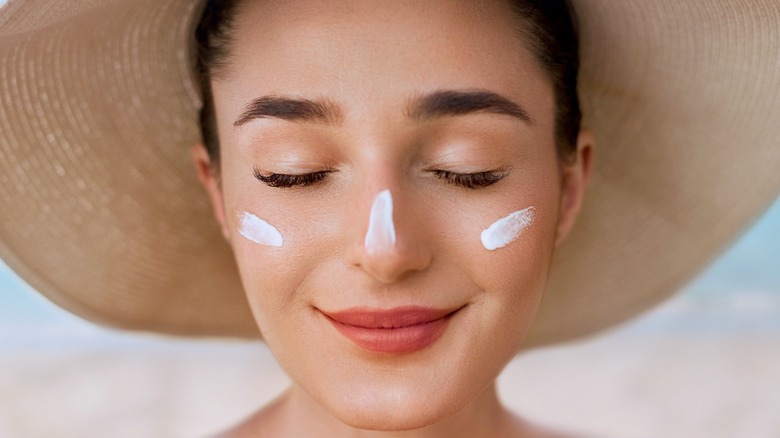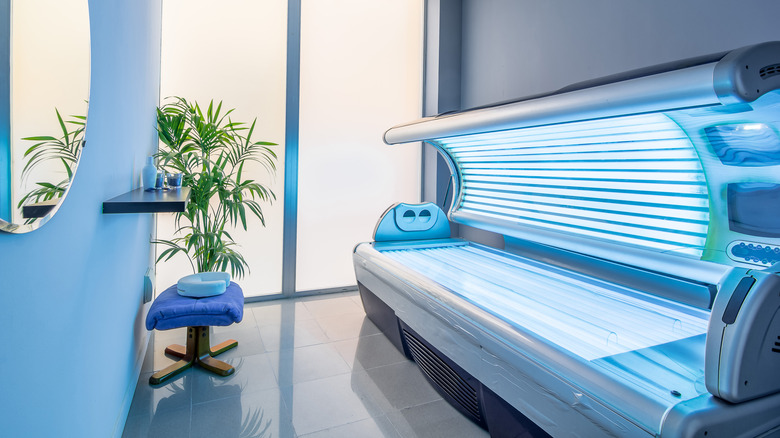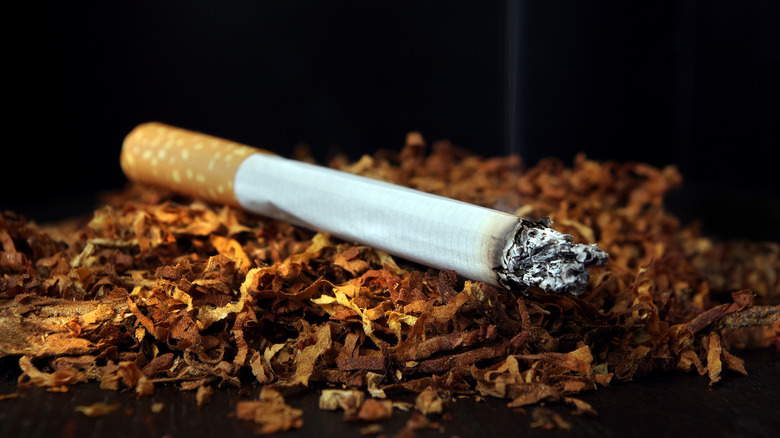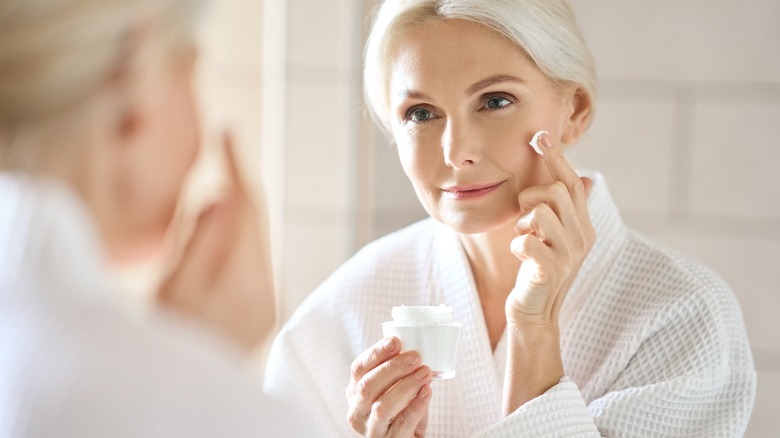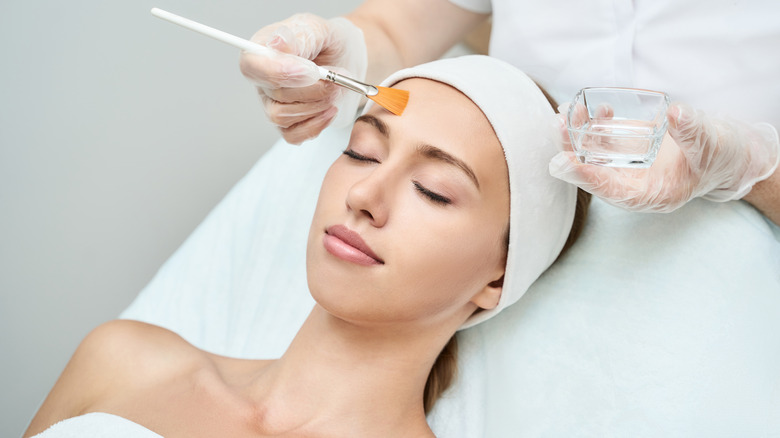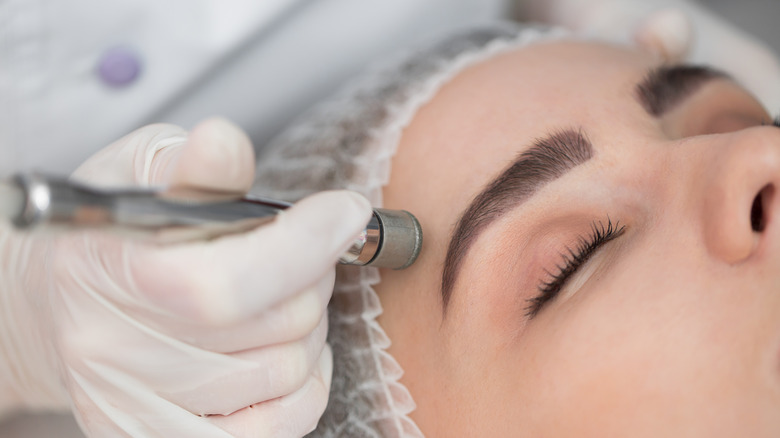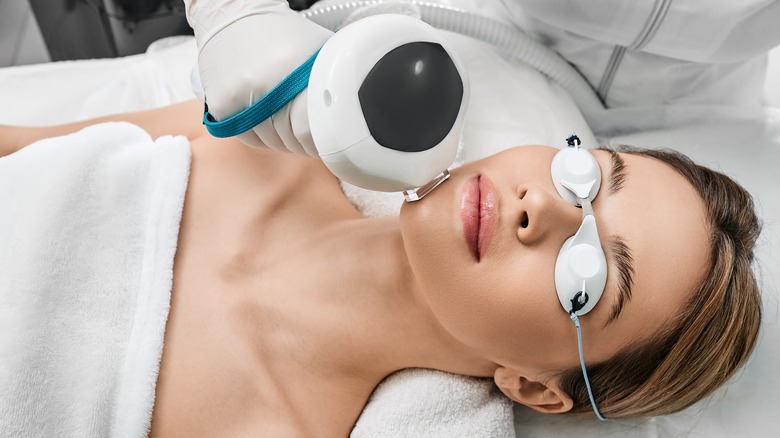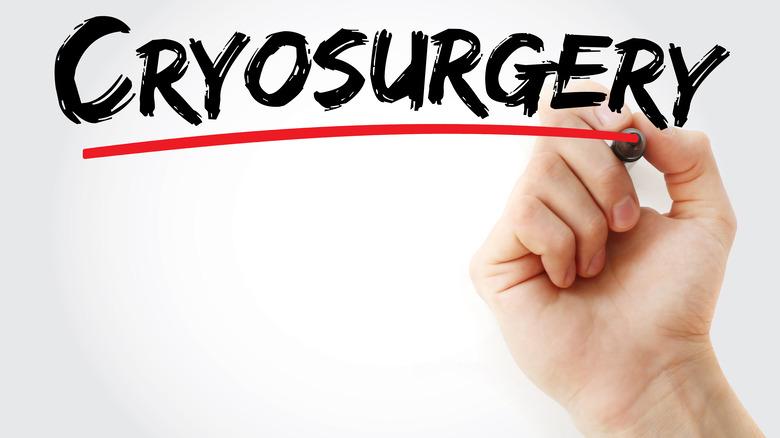What Are Age Spots And How Can You Prevent Them?
Which of the following is another term for age spots: a) liver spots, b) sunspots, c) solar lentigines, or d) all of the above. If you guessed "all of the above," then you're absolutely right. Like many things, age spots go by more than one name (per the Mayo Clinic). And this can cause some confusion.
But no matter what you call them, age spots typically have certain features like being small and flat. Although all skin types can develop them, they're especially common for individuals with fair skin and usually occur on areas like the face, backs of your hands, shoulders, upper back, and the tops of your feet. And this is no coincidence since these parts of the body tend to be constantly exposed to sunlight. As we'll discuss, ultraviolet (UV) rays and age spots usually go hand in hand — but they're not the only factor you should consider when it comes to these changes in your skin.
While there are ways to lighten or remove age spots, it's better to not develop them in the first place since having them could point to other health concerns, according to the Mayo Clinic. So, if you suspect you have age spots, make an appointment with a medical professional (a dermatologist comes to mind). With that said, understanding age spots better can help you discuss treatment options and ways to prevent future spots from developing.
What do they look like?
Imagine you have two friends who both have age spots, but their spots are different sizes and colors. Could this mean one of them has a different type of spot? Yes, but it's possible that both your friends have age spots despite their spots' different appearances.
As Healthline explains, age spots aren't all identical even though they can share certain characteristics. For example, a person could have age spots that are no bigger than a freckle while another person could have one as large as an inch in diameter. They can also happen in groups or individually and can be either round or oval in shape. And their colors can vary although they usually fall somewhere between light brown and black. Despite these variations, however, age spots typically have defined edges, are flat, and have "the same texture as the rest of your skin" (per Healthline).
Even though age spots can vary in appearance, a medical professional like a dermatologist will still look for these common features when determining if a spot is in fact an age spot. Potential red flags that a spot might be something more serious than an age spot include its color, having "irregular borders," and if it bleeds. But even if you have a spot that checks all of the descriptive boxes when it comes to age spots, you should still have it examined by a medical professional, especially if it changes in size or shape.
Common misconceptions about age spots
There's a joke that we park in a driveway and drive on a parkway. Like many jokes, it points out a truth: Sometimes the name or term we use for something can be misleading. Case in point, some of the names for age spots might give you the wrong ideas about them.
Because the term "age spots" has the word "age" in it, it's easy to assume that they only happen to people who are older. But as the Cleveland Clinic explains, while they're especially common in people who are over 50, technically a person can develop age spots at any time in their lives. In fact, according to the American Society for Dermatologic Surgery, even children could have age spots. Additionally, Health Central notes that age spots are sometimes called liver spots, which might be because of an outdated belief that they occur because of liver problems. However, liver spots do have something in common with the liver: They can be the same color as it.
Besides some of their more confusing names, many believe that age spots are cause solely by external factors like sunlight (via Cleveland Clinic). But as we learn more about them, we've found evidence that there can be a hereditary component to age spots. This means that even if two people are exposed to the same potential age spot-causing factors, one might be more likely to develop them because of family history.
Are they dangerous?
As the public becomes more educated about skin cancer, it's only natural to worry when you notice any changes to your skin. So, it's not surprising that you might be concerned if you start developing age spots. And there's a chance you should be concerned — but not for the reason you're probably thinking.
Okay, let's clear something up right away. According to the Mayo Clinic, while age spots might look similar to cancerous growths, they're not. But the fact that someone has age spots might indicate that they've gotten a great deal of sun exposure on that area of their body, and so might have serious skin damage. Also, because it can be hard to tell the difference between age spots and cancerous growths, self-diagnosing a skin change could delay important treatment and allow a dangerous health condition to escalate. As Healthline notes, skin cancer can occur on the same areas of the body as age spots like the hands and face. So too can actinic keratoses (which can become squamous cell carcinoma) and seborrheic keratoses, a type of skin growth that can look very similar to melanoma.
The bottom line is if you have any types of growths or changes to your skin, have a medical professional diagnose you (via Healthline). Remember, while it can be frightening to consider the possibility of a serious skin condition, the sooner you are professionally diagnosed and given proper treatments, the better the chances at a good outcome.
Radiation therapy can cause age spots
If a medical professional recommends a treatment, especially for a serious health condition, you shouldn't not do it because you might develop age spots. With that said, it's always good to be aware of the possible side effects of treatments like (for example) radiation therapy.
According to the National Cancer Institute, radiation therapy or radiotherapy is an option available to cancer patients. Now, chances are you've had some experience with radiation. If your dentist ever took an x-ray of your teeth, then you were exposed to a low dose of radiation. But a high dose of radiation can be used to shrink tumors and either kill or slow the growth of cancer cells (which eventually can cause them to die). Typically, this type of cancer therapy takes weeks to be effective, and as the Cleveland Clinic notes, a potential side effect of it is the development of age spots.
In addition, a patient who is receiving radiation therapy might experience other side effects that can vary based on what part of the body is being treated (via National Cancer Institute). For instance, radiation therapy that focuses on the chest could result in a cough. It can lead to issues with your memory and concentration if it's used to treat a brain tumor. So, even if age spots aren't a concern, you should still have a discussion with your health care professional before starting this type of treatment.
Limit sun exposure to help avoid age spots
If you're researching age spots, you might have noticed that two terms keep coming up for them: solar lentigo and solar lentigines (via Coast Dermatology Medical Associates). So there's no confusion, lentigo is the singular form of lentigines. With that cleared up, let's shift our focus to the solar part of that name for age spots since there's a connection between sun expose and these changes to your skin.
As Coast Dermatology Medical Associates explains, age spots can technically happen anywhere on your body but usually occur on areas that are exposed to the sun. According to Healthline, there's some gaps in current knowledge as to why people develop age spots, but evidence points to ultraviolet (UV) radiation from the sun being a major factor. In fact, it's more likely someone will develop these spots if they are frequently in the sun. And that's not all. Besides age spots, high amounts of sun exposure and sun damage can lead to other skin issues like actinic keratoses. And UV radiation can lead to skin cancer, according to the Centers for Disease Control and Prevention (CDC).
If you're concerned about sun exposure, there is a simple way to reduce your contact with UV rays. The CDC recommends not being in the sun from 9:00 a.m. to 3:00 p.m. standard time since this is when the UV rays are at their strongest.
Sunscreen can help prevent age spots
If you're worried about sun exposure, your first instinct might be to stay out of the sun altogether. But unless you've been advised to do so by a medical professional, this is probably not the most practical or healthiest idea. After all, as the Centers for Disease Control and Prevention (CDC) points out, sunlight has vitamin D, which is important for your body.
As Medical News Today explains, your skin produces more of a pigment called melanin to protect itself from UV rays, but this pigment can also lead to age spots. According to the American Academy of Dermatology Association (AAD), by applying water-resistant sunscreen that has at least a Sun Protection Factor (SPF) of 30 and is formulated to protect against both UVA and UVB rays, you're less likely to develop age spots. In fact, AAD advises putting on the sunscreen indoors and then waiting 15 minutes before going outside. And if you're thinking that you only need to use sunscreen on hot, sunny days, think again.
As the CDC notes, UV rays make it to the earth's surface even if the weather is overcast and cool. Additionally, things like snow, water, sand, and cement can reflect these rays. So, whether you're spending a day at the beach or going skiing, you should still protect your skin.
Protective clothing might make a difference
Often when you think of clothing, the first things that come to mind are fashion and style. After all, what clothing you pick to wear tends to be very subjective. But the right clothing choices might also help reduce the chances of developing age spots.
Remember, there's ultraviolet (UV) radiation in sunlight, and as dermatologist Dr. Amy Kassouf told the Cleveland Clinic, when a person is exposed to large amounts of it, their skin creates more melanin as a way to protect itself. This could lead to age spots, as well as other skin issues, including skin cancer. However, choosing clothing that can absorb or block UV rays, can help shield your skin from this harmful radiation (via Skin Cancer Foundation). And a good place to start is to check the Ultraviolet Protection Factor (UPF) of an article of clothing since that will let you know how much UVA and UVB radiation makes it through the garment to your skin. The Skin Cancer Foundation recommends at least a UPF of 30 while 50+ rates are exceptional protection.
In addition to UPF rates, clothing that's made from materials like unbleached cotton, wool, denim, canvas, synthetic fibers, satiny silks, or shiny polyesters can offer protection against UV rays, according to the Skin Cancer Foundation. You also want to opt for clothes that are loose-fitting, since stretched material is more likely to let UV rays slip through. Also, bright or dark colors absorb more UV radiation.
Don't use UV tanning devices
While sunlight is a concern when it comes to age spots, it's not the only way a person can be exposed to ultraviolet (UV) light (via Anne Arundel Dermatology). Remember, tanning devices like tanning beds, booths, and lamps all use this radiation, explains the Environmental Protection Agency (EPA). What's more, there are concerns about these products that go beyond age spots.
According to the Mayo Clinic, commercial tanning beds and lamps could eventually lead to the development of age spots. However, Anne Arundel Dermatology also warns that tanning beds could increase the odds of other skin issues like wrinkles and premature aging, as well as affecting one's skin's texture. It's also important to remember that UV rays don't just sit on the surface of the skin but can penetrate it and so remain and accumulate. There is even research that suggests the earlier someone begins using indoor tanning devices, the greater the odds they'll develop melanoma at some point in their lives. Additionally, Anne Arundel Dermatology points out that, "The exposure from tanning beds is 10-15 times more intense than that of the midday sun."
The EPA advises on its website against using tanning beds, booths, and lamps. Even if you don't use these devices, still checking your skin on a monthly basis for any changes, and having a friend or family member assist you with this check is smart practice. And, of course, make sure to have a medical professional check your skin regularly.
Smoking can increase the chances of age spots
The respiratory system isn't the only part of the body that can be negatively impacted by smoking. According to WebMD, there's evidence that smoking can affect your skin, including increasing the chances of developing age spots. Furthermore, smoking keeps your skin from getting the nutrients and oxygen it needs. This is why a person who smokes might develop a pale or uneven skin tone. "In young nonsmokers, we don't usually see a lot of uneven skin tone. But this develops more quickly in people who smoke," says dermatologist Dr. Jonette Keri (per WebMD). Data also suggests that smokers are more likely to experience psoriasis, as well as lines around the lips and wrinkles by their eyes known as crow's feet.
Of course, not smoking at all is the best way to lower the chances of developing age spots, another skin issue, and/or other health problems connected to smoking. But if you're already a smoker, WebMD notes that quitting smoking can help reverse at least some of the damage (for example) to the skin. So, if you need some help quitting, you might want to speak with your health care professional. The Centers for Disease Control and Prevention (CDC) also has resources available online.
Topical treatments and medicines can help with age spots
A common question for someone who's already developed age spots is: Can you either get rid of them or minimize their appearance? The short answer? Yes, you can. There's even topical treatments available (via the Cleveland Clinic). But there are some things to keep in mind.
According to WebMD, there are over the counter (OTC) products like creams that might help with age spots. However, it's important to be a conscientious consumer and read the ingredients on these products. For example, a cream that has kojic acid, tranexamic acid, or niacinamide is usually preferable. But products containing mercury (or that say mercuric), quicksilver, cinnabaris, hydrargyri oxydum rubrum, and/or calomel could be dangerous because they can hurt your nerves and liver. In fact, if you're using a product with any of these ingredients, you could also endanger others who come in contact with you. So, it's a good idea to speak with a medical professional before trying even an OTC treatment.
Speaking of which, there are prescription treatments for age spots, which can be specially formulated to meet an individual's skin's needs (per WebMD). These can include a cream called hydroquinone that can be used by itself or in conjunction with retinoids and a mild steroid, according to the Cleveland Clinic. Keep in mind that both OTC and prescription treatments can take months of continual use to fade age spots, and there's always a chance of skin irritation.
You might want to try a chemical peel
The term chemical peel might sound unappealing and even a bit concerning. And yes, there are possible risks associated with this procedure, according to the American Society for Dermatologic Surgery (ASDS). But if you have age spots, it is worth considering.
As ASDS explains, a chemical peel removes the outer layer of skin. In doing so, it can help lessen age spots. However, this isn't a walk in and have it done on the spot (no pun intended) type of procedure. Instead, a medical professional like an ASDS dermatologist will need to conduct a physical exam and speak with the patient about their medical history. This can include if they've had facial x-rays and scarring, as well as if they get reoccurring cold sores since chemical peels can reactivate cold sores. So, it's important to be honest about your medical history and current state of health.
Even when done by a professional, a chemical peel can still cause swelling, redness, and blisters (via the ASDS). It also could cause scarring and changes in one's skin color (either on a temporary or permanent basis). Additionally, there are post-procedure don'ts like keeping out of the sun for months and not using medications like glycolic acid, Retin-A, and Renova. Because of this, it's a good idea to bring a list of all supplements, medications, and treatments you're taking both orally and topically to make sure there's nothing that might be problematic.
Dermabrasion versus microdermabrasion
If your friend asked you to buy an apple for them, would you come back from the store with a pineapple? Chances are that you wouldn't, even though apples and pineapples are both fruits and have similar names. Similarly, dermabrasion and microdermabrasion are both procedures that might help with age spots. But there are some key differences between them.
If you've ever watched a home improvement show, you've probably seen a person sand a piece of wood to make it smoother. While not the same thing (and definitely not involving the same tools), this is a good analogy for dermabrasion. As the Cleveland Clinic explains, dermabrasion involves cooling the area of skin being treated and then using an instrument to plane it. But even though this can be an effective treatment for age spots, as well as other skin-related concerns like scarring and wrinkles, the American Society of Dermatologic Surgery (ASDS) states that dermabrasion can cause tissue damage, loss of skin color, redness, swelling, scarring, and even infection.
In addition, someone having dermabrasion done should expect some downtime. On the other hand, microdermabrasion, which is when very small crystals are sprayed on an area of the skin, "requires minimal downtime" (via the Cleveland Clinic). And while the ASDS shows less risks for this procedure, microdermabrasion can still irritate your skin, and also cause infection. The bottom line: Both dermabrasion and microdermabrasion should only be done by a medical professional.
What is Intense pulsed light (IPL) treatment?
WebMD points out that Intense pulsed light (IPL) treatment might help with more than just age spots. But that doesn't mean this treatment is for everyone. As its name would suggest, IPL therapy or photofacial uses wavelengths of pulsating light to heat your skin, allowing it to rid itself of "unwanted" cells. Now to be clear, this isn't the same thing as using a laser. And unlike other procedures used to treat age spots, IPL therapy isn't surgical, meaning it typically requires less downtime. That doesn't mean, however, that IPL doesn't come with a list of potential side effects like infection, scarring, pain, blisters, crusty skin, swelling, bleeding, and changes to the color of your skin. So, this treatment should only be done by a medical professional like a board-certified dermatologist or (depending on their training and experience) a nurse or physician assistant.
While IPL treatment can help with age spots, it also is used to get rid of or lessen other skin-related concerns like scars, broken blood vessels, spider veins, freckles, fine wrinkles, and even unwanted hair (per WebMD). With that said, a medical professional might advise against this procedure if the patient has certain skin conditions, is on a particular medication, or is pregnant.
Additional age spot treatments
Sometimes a patient might feel uncomfortable asking a medical professional certain questions. For instance, if a doctor makes a recommendation about how to treat a health concern, the patient might be concerned that it would be insulting to ask if there's another treatment option. But here's the truth: Knowing all the possible ways to approach a concern (including the pros and cons) is very important.
As the American Society for Dermatologic Surgery (ASDS) explains, you can opt to have a medical professional use liquid nitrogen solution to freeze the area of the skin affected by age spots. This procedure is called cryosurgery. And, yes, like other treatments for age spots, there can be side effects — temporary redness, swelling, pain, and the crusting of your skin, for instance. Also, cryosurgery can cause scarring and the treated area becoming lighter in color. Additionally, someone with age spots can try laser treatments, which can get results faster than with topical treatments like creams (via the American Academy of Dermatology Association). However, lasers can also have side effects, including the age spots' color becoming darker before they fade.
The bottom line is if you have age spots, don't be afraid to talk with a medical professional about all your treatment options. This way you both can craft the best approach for your needs.

